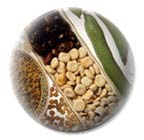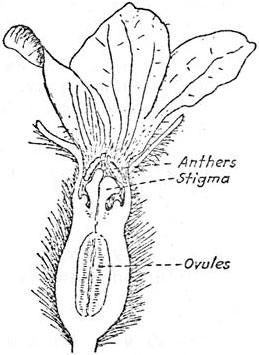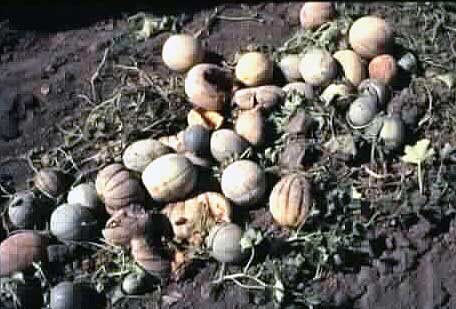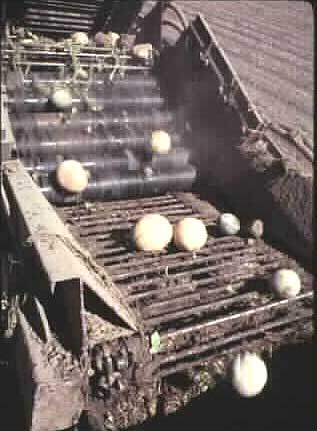- Home
- Introductions

|
Vegetable Seed Production:
|
||||||||||||||||||||||||||||
 |
Common Name: Cantaloupe
and mixed melons Scientific Name: Cucumis melo Family: Cucurbitaceae |
 |
In addition to reading the information in this section,
please view this multimedia presentation on Cantaloupe. (Youtube link) |
Botany
Please note that netted and winter melons are in the same genus as cucumber so a number of characteristics for these crops are similar. Commercial types are warm-season (frost sensitive) annuals that are cross pollinated by bees. Sex expression is andromonoecious. Commercial plants are day-neutral. Plant habit is vining with varied internode length.
|
|
Staminate inflorescence of a melon plant, showing a staminate flower and several male buds. |
Bush cultivars have been developed but are not widely grown commercially. Most cultivars have tendrils and flowers have 5 yellow petals that are open for a single day like cucumber. However, leaves differ from cucumber in being circular, oval, or kidney shaped with 5 to 7 rounded lobes.
 Section through a hermaphroditic flower of a melon |
Ovary cross section |
Some controversy exists regarding the designation of Groups within Cucumis melo.
Some texts continue to show Cantaloupensis and Inodorus as botanical varieties. Some reference books list Reticulatus as the correct botanical variety or group for netted melons.
Soil Nutrition
Muskmelon tend to develop extensive root systems that efficiently explore the soil for water and available nutrients. For this reason, fertilizer requirements are moderate compared with many other vegetable crops. Fertilization should be done in accordance with soil and foliar test results. Nitrogen (N) is the most commonly required fertilizer, although phosphorous is sometimes needed to promote good seedling vigor, maximum production and high fruit quality, especially in alkaline soils. Most mineral soils contain adequate potassium, but it may be deficient in areas with light soils. Common nutrient needs for a muskmelon crop grown on a loam soil are 100 to 120 lbs. Of N per acre and 80 to 100 lbs. P2O5 per acre as a general fertilizer program. Greater amounts may be needed in sandy soils.
Phosphorus fertilizer, as liquid 10-34-0 or 0-52-0, is commonly injected in twin bands 6 inches deep and 4 to 6 inches to either side of the melon seed lines before planting or in drip irrigation lines as part of a fertigation program. It also can be broadcast and lightly incorporated before beds are formed, but alkaline mineral soils chemically tie up phosphorus, making it unavailable to the plants. Thus, banding the fertilizer near the seed is preferred over broadcast application.
Nitrogen is commonly applied in two side-dressings or as fertigation, the first at the 2-4 leaf stage and the second when vines start to develop runners. Plant tissue analysis of melon petioles is the most effective means of diagnosing the nutrient status of the crop. Nutrient status should be monitored and maintained at its optimum level throughout the life of the crop for maximum fruit yields and quality.
The goal is to grow plants with a large canopy of leaves, maintaining healthy leaves as long as possible. This can be done by maintaining adequate levels of N, P, K, S, Ca, Mg, B, Cu, Fe, Mn, Mo and Zn. However, care must be taken to not over-fertilize the crop, especially with nitrogen. Excessive nitrogen favors vegetative growth over reproductive growth and can inhibit fruit set. The N level, especially ammoniacal N, must be low enough at flowering that the plant will form fewer new leaves after fruit growth begins. This allows more sugars to go to the fruit, rather than to developing leaves and vines.
Isolation
The ideal minimum isolation distance for commercial seed production is 1000 m although some authorities specify distances of only 500 m. It is extremely important that there is adequate isolation between commercial crop and seed crop fields of the different types of melons as they are very cross- compatible.
Pollination
Cucurbits require that pollen move from staminate to pistillate flowers or from the anthers to the stigma of perfect flowers. Honey bees are the msot reliable and cost-effective way to achieve pollination. One to two hives per acre are introduced when 5 to 10 percent of the plants have open flowers. If hives are placed in weedy areas or close to other flowering crops, the number of hives per acre should be increased. Hives should be placed in clusters around the periphery of fields, with additional hives placed inside of larger fields.
F1 hybrids dominate the market for most commerical cucurbit crops due to their greater vigor, higher yield, and greater uniformity than open-pollinated varieties. In addition, since parent lines are proprietary and seed cannot be propagated for a second generation from hybrid seed, seed company investments in varietal research and development are more secure.
Hybrid seed production using plant hormones is not currently feasible for cantaloupes, mixed melons (honey-dew, crenshaw, casaba), or watermelon because they have bisexual flowers that must be emasculated and hand-pollinated. Hybridization of these crops requires extensive hand labor. As a result, hybrid seed production occurs outside the United States where labor is relatively inexpensive and abundant.
Planting
In the Western US and some places in the East, muskmelon are generally grown on raised beds (6 to 8 inches).
Final spacing of the beds in furrow irrigated culture is generally 80 inches center-to-center. Beds can be made and shaped to final spacing before planting or to one-half final spacing (40 inches). In the latter procedure, every other bed is seeded at planting. When plants begin to vine, unplanted beds are broken open and the field is reworked to position the plant row in the middle of the final 80-inch bed.
Muskmelon require soils that are fairly fertile, and well drained. Maximum yields are achieved on medium-textured soils with high water-holding capacity and good internal drainage. They can be grown on a wide range of soils, although peat or heavy clay soils are not recommended. Clay soils generally have poor aeration and restricted drainage, which reduces root growth and thus fruit quality.
Muskmelon are sensitive to acid conditions, but will grow well on slightly acidic (pH 6.8) to moderately alkaline (pH 8.0), soils. Muskmelon are quite sensitive to salinity, so soils with high salt content should be avoided.
A crop rotation cycle of several years between planting members from the family Cucurbitaceae (muskmelon, pumpkin, watermelon, etc.) is sometimes required if pathogen populations are very high and fumigation is not used. When possible, grasses, corn or sorghum are good rotation crops. However, herbicide carryover (for example, atrazine) may inhibit muskmelon growth.
In the Eastern United States, plastic mulches are often used for muskmelon production.
In the most common application, plastic film is stretched over the top of an 80-inch bed and secured with soil at the edge of the bed. Planting is by direct seeding or transplanting through holes punched or burned in the plastic cover. Drip irrigation or fertigation is used with this plasticulture system. Black plastic is used to aid weed control, clear is used in northern areas to increase early season soil temperatures, and other colors are sometimes used for insect control.
For early season plantings in some areas, seeds are planted in a plastic-covered trench approximately 18 inches wide and 6 inches deep in the center of a standard east-west, 80-inch bed. After planting seed in the bottom or on the north slope of the trench, clear plastic is stretched over the trench and fastened with soil at its edges. The plastic cover is removed when plants are established and temperature control is no longer needed. This system also provides insect protection as long as the plastic cover remains intact.
The third use of plastic covers is in tunnels, constructed by stretching clear plastic over hoops placed over the planted beds. This technique allows use of plastic covers longer than with trenches, but is more expensive. Black plastic mulch may be used underneath the clear plastic tunnels for weed control.
Irrigation
Muskmelon have extensive, moderately deep, root systems that efficiently explore the soil for water, so irrigations can be more widely spaced than with some other vegetable crops. Three to five irrigations are typically applied to a crop. Preplant or post-plant irrigations should be applied to ensure seed germination, emergence and stand establishment. Irrigation is then held off until the pre- vining stage to avoid cooling the soil, encouraging damping-off diseases and encourage deep-rooting. The last irrigation is typically applied 7 to 10 days before harvest begins, but may vary depending on soil type, air temperature, humidity, etc.
Drip irrigation, either with or without the use of plastic, is commonly used particularly in the eastern US. This irrigation methods provides the most uniform application of water with the least amount of water used. Sprinkler irrigation is frequently used during stand establishment, but this is not a good system once the vine canopy has become large, because it may result in significant vine and fruit disease.
Furrow irrigation is the least efficient, least uniform, but most common method of irrigation in the Western US. When using furrow irrigation, care must be taken to ensure (1) that water gets to the seed or root zone, and (2) that after vines start to run, the top of the bed does not get wet as this encourages fruit rot. More muskmelon plantings are easily damaged by too much water. Common problems caused by excessive water are (1) poor root system that may lead to vine collapse as the crop reaches maturity, (2) poor fruit netting, and (3) low sugar in mature fruit.
Roguing
Melon roguing stages and main characters to be observed:
1. Before flowering; vegetative habit, characters of undeveloped
fruit.
2. After flowering commences: check fruit type.
3. Fruit set: check fruit type and coloring.
4. Harvesting: check fruit type and coloring.
|
Diseases |
Insect Pests |
|
|
Seed Harvest
Cantaloupe and musk-melons tend to separate from the stem at the base of the fruit as the fruit becomes fully mature.

Range of muskmelon fruit maturities at harvest
Large-scale melon seed producers leave the entire crop of fruit to separate
in this way before passing through the field with a cucurbit seed harvester
or picking up by hand and conveying the fruit in baskets to the seed extractor
which moves through the field.
 |
 |
|
Vines are cut and the fruits
are carried up the conveyor into the machine.
|
Vines are removed by rollers
and the fruits are moved into cutters that slice them open.
|
The winter melons do not form an abscission layer or 'full slip' when
mature; maturity is indicated by color change from green to yellow or
yellow to white (according to the rind color of cultivar). In addition
to the external color change the blossom end of the fruit softens and
the coat becomes waxy and its aroma increases.
Cleaning
Melon seed is not fermented before washing to separate the seed from other fruit material. After washing the seed is dried as described for watermelon. Final separation of dried fruit debris and light seeds can be made by passing the seed-lot through an aspirated screen cleaner.
Seed Yield
The average yield of seed is about 300 kg per hectare, although the best melon seed production areas can achieve up to 600 kg.
Seed Identification:
| Scientific Name: | Cucumis melo |
| Common Name: | Cantaloupe |
| Family: | Cucurbitaceae |
| Weight: | The 1000 grain weight of melon seed is 25 g. |
|
|
|
| Print image with name - Print image without name | |